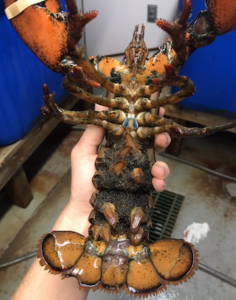Do small female lobsters produce lower quality eggs?
Funding agency: NOAA Saltonstall-Kennedy Grant
Investigators:
David M. Fields, Bigelow Laboratory for Ocean Sciences
Richard A. Wahle, University of Maine, School of Marine Sciences
Graduate Student Investigators:
Alex Ascher, University of Maine, School of Marine Sciences
Partners:
Maine Department of Marine Resources (ME-DMR)
Rhode Island Department of Environmental Management; (RI-DEM).
Letter of endorsement – Atlantic Offshore Lobsterman Association (AOLA)
Rising temperatures have caused the American lobster, Homarus americanus, to mature at a smaller size and produce fewer eggs per female. However, it is unknown if smaller maternal size also affects egg quality and/or the performance of their offspring.
Recent evidence suggests smaller females invest less energetic resources per egg than large females. In addition, eggs from smaller females appear to contain lower total omega-3 fatty acid. The consequences of these changes in egg quality and quantity for larval performance are unknown. It is reasonable to hypothesize that lower quality eggs lead to lower performance and survival during early larval development, particularly when challenged with the increased energetic demands of higher temperature (Waller et al. 2016).
The goal of this work is to evaluate egg quality across thermally contrasting regions, and to compare small and large reproductive female lobsters with respect to egg quality and the performance of their larval stages.
Objective 1 evaluates how female size impacts fecundity and egg quality at 3 study areas spanning New England’s steep thermal gradient.
Objective 2 evaluates larval performance as a function of maternal size. Larval rearing experiments will be conducted at Bigelow Laboratory to assess growth, morphology and physiology of larvae originating from females of a range of sizes.

Image: Ovigerous lobster
